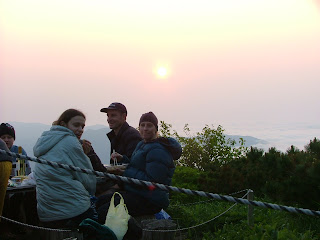

Raise your hand if you have climbed to the top of a Japanese volcano. We had a weekend with nothing else booked so we jumped on the chance to get out of the city and do just that. Yotei-zan is an inactive volcano in the Shikotsu-Toya National Park south of Sapporo and is otherwise known as Fuji of the north or Ezo-Fuji. It is the tallest volcano in Hokkaido and is only a short drive from Sapporo. We didn’t want to miss our chance to climb a Japanese volcano and be the first to greet the red sun as it rises over the Pacific, so we hired a car and off we went.
We left town early on Saturday, took our time getting groceries and enjoying a meal in Niseko (a ski town close to Yotei) and got to the parking lot at the trail head around 2:00. The hike up to the hut takes about 5 hours and we were hoping to hit the hut by sunset. The trail initially winds slightly uphill through a nice park-like area; this continues for about all of 15 minutes before the trail takes a hard right and the uphill incline begins. The trail angle is about 60 degrees and this continues all the way up the mountain (honestly, 5 hours of that kind of incline without a break). It is a relentless trail and I felt like a bag of pathetic huffing and sweating my way up as we were greeted by happy, fit looking 65 year old ladies on their way back down from the summit.
The steep trail - me and our downstairs neighbour (a British masters student) behind me.

The forest soon gave way to scrubby, winter-worn shrubs, which in turn gave way to thick underbrush and beautiful alpine flowers. We were lucky to be there while almost every plant we passed was in bloom. The trail we took (the one closest to Grand Hirafu) led us up to a point a clockwise quarter way around the mountain from the hut, so we traversed through the alpine to get to the hut. We arrived to see about 20 other hikers already enjoying a rest for their legs and some dinner at the small picnic table outside the hut. We put our packs down inside, paid our 800 yen for the night stay and went back outside for a sunset dinner. Before we left we were told that there were no fires allowed in the park and that included camp stoves. We thought that was a bit odd, but went ahead and planned an easy no-cook meal of convenience store soba noodles, onigiri (rice ball wrapped in seaweed and stuffed with fish), cheese and a nice bottle of wine. It turned out that our adviser was wrong and camp stoves were allowed, but the ease of our meal (no cooking or washing dishes after) was a surprising treat.
Our sunset dinner with some fellow gaijin hikers.

The hut has a 9:00 curfew that we thought we would have a hard time sticking to, but with sunset at about 7:30, no lights in the hut or outside and most of the hikers intending to summit the next morning for the 4 am sunrise, it was just the right time for bed. It certainly would have been nice if we could have slept. The hut is a big open space with no separated rooms. Hikers all sleep side by side on the floor and I suppose if everyone just went to bed at 9:00 it would have worked out ok. There was a guy about 3 feet from us who thought it was a good idea to get some extra energy for the next morning and opened a bag of peanuts or crackers or some other insanely loud sounding food at 11:00 and continued crunching through till midnight. The guy next to him was busy sending text messages on his cell phone for a few hours. Another woman had to go into her pack and find things all night, and amazingly everything she brought was wrapped in 2 layers of noisy crunchy plastic that for some reason needed to be rewrapped before putting it away. Hikers started rustling around at 2:00 am to prepare for the sunrise summit. We tried to get another half hour or so of sleep but it was pointless. Everyone felt it necessary to pack their entire packs, bedrolls and have a chat while doing it before leaving, making an enormous racket. I guess if you can’t beat ‘em, join ‘em, so we left the hut just before 3 am heading for the top of the volcano to watch the sunrise.
We made it to the top of the caldera with plenty of time to get a nice seat, eat some breakfast and watch the show.

Hanging out over the caldera - it was deeper than I expected.

The highest point on the volcano.

It was a beautiful sunrise (asahi is the Japanese word for sunrise – yes, like the beer) and the weather was good. The mountain was skirted in clouds that had moved in overnight and it made the ambiance even more fairy tale-esque. After greeting the sun, we walked around the caldera then back down to the hut where our hiking partner had opted to sleep while the noisy people were out. We packed up and hung around the hut for another few hours before the big walk down. For me, down is always more painful than up, so Shawn was patient while we took it slow.

We cleverly stashed ourselves an incentive beer and some fresh fruit in the cooler at the bottom. We savoured our rewards and headed back to Sapporo and city life. It was great to get out of the rat race even just for a couple of days.














